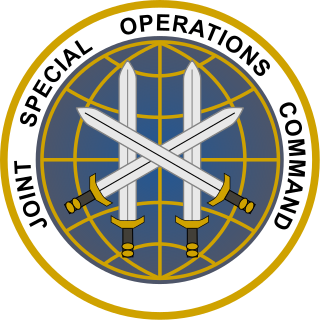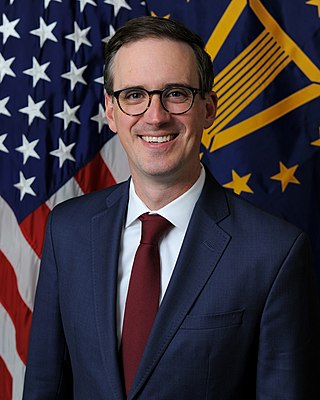
The Joint Chiefs of Staff (JCS) is the body of the most senior uniformed leaders within the United States Department of Defense, which advises the president of the United States, the secretary of defense, the Homeland Security Council and the National Security Council on military matters. The composition of the Joint Chiefs of Staff is defined by statute and consists of a chairman (CJCS), a vice chairman (VJCS), the chiefs of the Army, Marine Corps, Navy, Air Force, Space Force, and the chief of the National Guard Bureau. Each of the individual service chiefs, outside their JCS obligations, works directly under the secretaries of their respective military departments, e.g. the secretary of the Army, the secretary of the Navy, and the secretary of the Air Force.

Counterintelligence (counter-intelligence) or counterespionage (counter-espionage) is any activity aimed at protecting an agency's intelligence program from an opposition's intelligence service. It includes gathering information and conducting activities to prevent espionage, sabotage, assassinations or other intelligence activities conducted by, for, or on behalf of foreign powers, organizations or persons.
The United States Navy Working Capital Fund (NWCF) is a branch of the family of United States Department of Defense (DoD) Working Capital Funds. The NWCF is a revolving fund, an account or fund that relies on sales revenue rather than direct Congressional appropriations to finance its operations. It is intended to generate adequate revenue to cover the full costs of its operations, and to finance the fund's continuing operations without fiscal year limitation. A revolving fund is intended to operate on a break-even basis over time; that is, it neither makes a profit nor incurs a loss.

Survival, Evasion, Resistance, and Escape (SERE) is a training program, best known by its military acronym, that prepares U.S. military personnel, U.S. Department of Defense civilians, and private military contractors to survive and "return with honor" in survival scenarios. The curriculum includes survival skills, evading capture, application of the military code of conduct, and techniques for escape from captivity. Formally established by the U.S. Air Force at the end of World War II and the start of the Cold War, it was extended to the Navy and United States Marine Corps and consolidated within the Air Force during the Korean War (1950–1953) with greater focus on "resistance training".

The Joint Special Operations Command (JSOC) is a joint component command of the United States Special Operations Command (USSOCOM) and is charged with studying special operations requirements and techniques to ensure interoperability and equipment standardization, to plan and conduct special operations exercises and training, to develop joint special operations tactics, and to execute special operations missions worldwide. It was established in 1980 on recommendation of Colonel Charlie Beckwith, in the aftermath of the failure of Operation Eagle Claw. It is headquartered at Pope Field.

The United States under secretary of defense for policy (USDP) is a high level civilian official in the United States Department of Defense. The under secretary of defense for policy is the principal staff assistant and adviser to both the secretary of defense and the deputy secretary of defense for all matters concerning the formation of national security and defense policy.

In the U.S., critical infrastructure protection (CIP) is a concept that relates to the preparedness and response to serious incidents that involve the critical infrastructure of a region or the nation. The American Presidential directive PDD-63 of May 1998 set up a national program of "Critical Infrastructure Protection". In 2014 the NIST Cybersecurity Framework was published after further presidential directives.

The under secretary of defense for intelligence and security or USD(I&S) is a high-ranking civilian position in the Office of the Secretary of Defense (OSD) within the U.S. Department of Defense (DoD) that acts as the principal civilian advisor and deputy to the secretary of defense (SecDef) and deputy secretary of defense (DepSecDef) on matters relating to military intelligence and security. The under secretary is appointed as a civilian by the president and confirmed by the Senate to serve at the pleasure of the president.

The Joint POW/MIA Accounting Command was a joint task force within the United States Department of Defense (DoD) whose mission was to account for Americans who are listed as Prisoners of War (POW), or Missing in Action (MIA), from all past wars and conflicts. It was especially visible in conjunction with the Vietnam War POW/MIA issue. The mission of the Joint POW/MIA Accounting Command was to achieve the fullest possible accounting of all Americans missing as a result of the nation's past conflicts. The motto of JPAC was "Until they are home".

Joint Task Force-Bravo is a forward-based expeditionary joint task force operating as U.S. Southern Command's (USSOUTHCOM) lead forward element in the Central America (CENTAM) region to promote stability and security and counter transnational and transregional threat networks (C-T3N). JTF-Bravo operates out of Soto Cano Air Base, Honduras, located 10 miles south of the city of Comayagua and 50 miles north of the capital city of Tegucigalpa.

The 1st Information Operations Command (Land), formerly the Land Information Warfare Activity Information Dominance Center (LIWA/IDC), is an information operations unit under the operational control of U.S. Army Cyber Command (ARCYBER) and headquartered at Fort Belvoir, Virginia.
The U.S.–Russia Joint Commission on POWs/MIAs (USRJC) was established in 1992 by the presidents of the United States and the Russian Federation, George H. W. Bush and Boris Yeltsin. The USRJC was established to determine the fates of the United States's and the Soviet Union's unaccounted-for service personnel from World War II, the Korean War, the Cold War, Afghanistan and the Vietnam War, Laos and Cambodia.

Foreign internal defense (FID) is a term used by the military in several countries, including the United States, France, and the United Kingdom, to describe an integrated, or multi-country approach to combating actual or threatened insurgency in a foreign state. This foreign state is known as the Host Nation (HN) under the US doctrine. The term counter-insurgency is commonly used for FID.

The Assistant to the Secretary of Defense for Public Affairs, or ATSD (PA), is the principal staff advisor and assistant to the Secretary of Defense and Deputy Secretary of Defense for public information, internal information, community relations, information training, and audiovisual matters in support of Department of Defense activities, leading a worldwide public affairs community of some 3,800 military and civilian personnel. The Assistant to the Secretary follows the Secretary's Principles of Information in providing Defense Department information to the public, the United States Congress and the media.

Combat Rescue Officer (CRO) is a Special Warfare Officer career field in the United States Air Force. Its Air Force Specialty Code (AFSC) is 19ZXC and it was created to strengthen USAF Special Warfare personnel recovery capabilities by providing commissioned officer leadership that possessed an operational skillset paralleling that of the enlisted pararescuemen (PJ). The CRO specialty includes direct combatant command and control of Combat Search and Rescue (CSAR) operations. They plan, manage and execute the six tasks of CSAR: prepare, report, locate, support, recover, and reintegrate isolated personnel and materiel. CROs conduct strategic, operational and tactical level planning, provide battle staff expertise, manage theater personnel recovery operations and conduct combat special operations.

The Joint Personnel Recovery Agency (JPRA) is a Chairman's Controlled Activity and is designated as DoD's office of primary responsibility for DoD-wide personnel recovery (PR) matters, less policy. JPRA is headquartered in Fort Belvoir, Virginia with schools located in Fredericksburg, VA and Spokane, WA. JPRA currently provides for commanders, forces, and individuals on joint PR activities through development and conduct of education and training courses, and specialized individual training. The agency assesses, advises, and evaluates PR curriculum and establishes Joint PR standards in collaboration with the DoD Components for formal Joint PR training, including Code of Conduct and SERE. JPRA also provides DoD Components with analytical support, technology research and integration, maintenance of databases and archives, and development of lessons learned. JPRA encourages partnerships by assisting with non-DoD agencies, multinational partners, and others, with PR-related education and training programs.
Defense Support of Civil Authorities (DSCA) is the process by which United States military assets and personnel can be used to assist in missions normally carried out by civil authorities. These missions have included: responses to natural and man-made disasters, law enforcement support, special events, and other domestic activities. A recent example of the use of DSCA is the military response to Hurricane Katrina. DSCA is the overarching guidance of how the United States military can be requested by a federal agency and the procedures that govern the actions of the military during employment.

Counter-IED efforts are done primarily by military and law enforcement with the assistance of the diplomatic and financial communities. It involves a comprehensive approach of countering the threat networks that employ improvised explosive devices (IEDs), defeating the devices themselves, and training others. Counter-IED, or C-IED, is usually part of a broader counter-terrorism, counter-insurgency, or law enforcement effort. Because IEDs are a subset of a number of forms of asymmetric warfare used by insurgents and terrorists, C-IED activities are principally against adversaries and not only against IEDs. C-IED treats the IED as a systemic problem and aims to defeat the IED threat networks themselves.

The Swedish Air Force Rangers (SAFR) (Swedish: Flygbasjägarna, FBJ), is an elite specialist ground unit of the Swedish Air Force. The name "Flygbasjägare" originates in the unit's old role during the cold war of conducting security operations around airfields and other air force installations. The current primary tasks of the unit are personnel recovery, reconnaissance and force protection.
The European Personnel Recovery Centre (EPRC) is an intergovernmental military organisation that contributes to the development and harmonisation of policies and standards related to personnel recovery. The ERPC also provides support for education, training, exercises and operations. The EPRC was established on 8 July 2015 and is based at Poggio Renatico Air Base in Italy.
















